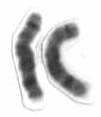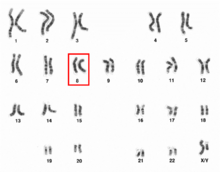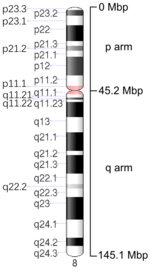Chromosome 8 (human)
| Chromosome 8 (human) | |
|---|---|
 Human chromosome 8 pair after G-banding. One is from mother, one is from father. | |
 Chromosome 8 pair in human male karyogram. | |
| Features | |
| Length (bp) | 145,138,636 bp |
| Number of genes | 1,534 |
| Type | Autosome |
| Centromere position | Submetacentric[1] |
| Identifiers | |
| RefSeq | NC_000008 |
| GenBank | CM000670 |

Chromosome 8 is one of the 23 pairs of chromosomes in humans. People normally have two copies of this chromosome. Chromosome 8 spans about 145 million base pairs (the building material of DNA) and represents between 4.5 and 5.0% of the total DNA in cells.[2]
The chromosome has two arms, 8p and 8q. The short arm, 8p, has about 45 million base pairs, about 1.5% of the genome, and includes 484 genes and 110 pseudogenes; about 8% of its genes are involved in brain development and function, and about 16% are involved in cancer. A unique feature of 8p is a big region of about 15 megabases that appears to have a high mutation rate, and which shows an immense divergence between human and chimpanzee, suggesting that its high mutation rates have contributed to the evolution of the human brain.[2]
Identifying genes on each chromosome is an active area of genetic research. Because researchers use different approaches to predict the number of genes on each chromosome, the estimated number of genes varies. Chromosome 8 is likely to contain between 700 and 1,000 genes.
Genes
The following are some of the genes located on chromosome 8:
- AEG1 : Astrocyte Elevated Gene (linked to hepatocellular carcinoma and neuroblastoma)
- ANK1: ankyrin 1, erythrocytic
- Arc/Arg3.1
- ASAH1: N-acylsphingosine amidohydrolase (acid ceramidase) 1
- ASPH: encoding enzyme Aspartyl/asparaginyl beta-hydroxylase
- AZIN1: encoding protein Antizyme inhibitor 1
- C8orf4: encoding protein Uncharacterized protein C8orf4
- C8orf32/WDYHV1: encoding enzyme Protein N-terminal glutamine amidohydrolase
- C8orf46: encoding protein Chromosome 8 open reading frame 46 (C8orf46)
- CHD7: chromodomain helicase DNA binding protein 7
- CHRNA2: cholinergic receptor, nicotinic, alpha 2 (neuronal)
- CLN8: ceroid-lipofuscinosis, neuronal 8
- CNGB3: cyclic nucleotide gated channel beta 3
- CYP11B1: cytochrome P450, family 11, subfamily B, polypeptide 1
- CYP11B2: cytochrome P450, family 11, subfamily B, polypeptide 2
- DPYS: dihydropyrimidinase
- COH1
- ESCO2: establishment of sister chromatid cohesion N-acetyltransferase 2
- EXT1: exostosin glycosyltransferase 1
- EYA1: EYA transcriptional coactivator and phosphatase 1
- FAM83H: family with sequence similarity 83, member H
- FGFR1: fibroblast growth factor receptor 1 (fms-related tyrosine kinase 2, Pfeiffer syndrome)
- GDAP1: ganglioside-induced differentiation-associated protein 1
- GDF6: growth differentiation factor 6
- GLI4: encoding protein Gli family zinc finger 4
- HGSNAT: heparan-alpha-glucosaminide N-acetyltransferase
- KCNQ3: potassium channel, voltage gated KQT-like subfamily Q, member 3.
- KIAA0196: KIAA0196
- LPL: lipoprotein lipase
- MCPH1: microcephaly, primary autosomal recessive 1
- NBN: nibrin
- NDRG1: N-myc downstream regulated gene 1
- NEF3: neurofilament 3 (150kDa medium)
- NEFL: neurofilament, light polypeptide 68kDa
- PDP1: pyruvate dehydrogenase phosphatase catalytic subunit 1
- PLEC: plectin
- RECQL4: RecQ protein-like 4
- RUNX1T1: runt-related transcription factor 1; translocated to, 1 (cyclin D-related)
- SFTPC: surfactant protein C
- SLC20A2: Sodium-dependent phosphate transporter 2
- SLURP1: secreted LY6/PLAUR domain containing 1
- SNAI2: snail homolog 2 (Drosophila)
- TG: thyroglobulin
- THAP1: THAP domain containing, apoptosis associated protein 1
- TMEM67: encoding protein Meckelin
- TNFRSF11B: tumor necrosis factor receptor superfamily, member 11b
- TPA: tissue plasminogen activator
- TRPS1: trichorhinophalangeal syndrome I
- VMAT1: vesicular monoamine transporter protein
- VPS13B: vacuolar protein sorting 13 homolog B (yeast)
- WRN: Werner syndrome
- GULOP pseudogene: responsible for human inability to produce Vitamin C
Diseases and disorders
The following diseases and disorders are some of those related to genes on chromosome 8:
- 8p23.1 duplication syndrome
- Burkitt's lymphoma
- Charcot-Marie-Tooth disease
- Charcot-Marie-Tooth disease, type 2
- Charcot-Marie-Tooth disease, type 4
- COACH Syndrome
- Cleft lip and palate
- Cohen syndrome
- Congenital hypothyroidism
- Fahr's syndrome
- Hereditary Multiple Exostoses
- Lipoprotein lipase deficiency, familial
- Pfeiffer syndrome
- Primary microcephaly
- Rothmund-Thomson syndrome, or poikiloderma congenitale
- Schizophrenia, associated with 8p21-22 locus[3][4][5]
- Waardenburg syndrome
- Werner syndrome
- Pingelapese blindness
- Langer-Giedion syndrome
- Roberts Syndrome
References
- ↑ "Table 2.3: Human chromosome groups". Human Molecular Genetics (2nd ed.). Garland Science. 1999.
- 1 2 Tabarés-Seisdedos R, Rubenstein JL; Rubenstein (2009). "Chromosome 8p as a potential hub for developmental neuropsychiatric disorders: implications for schizophrenia, autism and cancer". Mol Psychiatry. 14 (6): 563–89. doi:10.1038/mp.2009.2. PMID 19204725.
- ↑ Blouin JL, Dombroski BA, Nath SK, et al. (September 1998). "Schizophrenia susceptibility loci on chromosomes 13q32 and 8p21". Nat. Genet. 20 (1): 70–3. doi:10.1038/1734. PMID 9731535.
- ↑ Gurling HM, Kalsi G, Brynjolfson J, et al. (March 2001). "Genomewide genetic linkage analysis confirms the presence of susceptibility loci for schizophrenia, on chromosomes 1q32.2, 5q33.2, and 8p21-22 and provides support for linkage to schizophrenia, on chromosomes 11q23.3-24 and 20q12.1-11.23". Am. J. Hum. Genet. 68 (3): 661–73. doi:10.1086/318788. PMC 1274479
 . PMID 11179014.
. PMID 11179014. - ↑ Suarez BK, Duan J, Sanders AR, et al. (February 2006). "Genomewide linkage scan of 409 European-ancestry and African American families with schizophrenia: suggestive evidence of linkage at 8p23.3-p21.2 and 11p13.1-q14.1 in the combined sample". Am. J. Hum. Genet. 78 (2): 315–33. doi:10.1086/500272. PMC 1380238
 . PMID 16400611.
. PMID 16400611.
- Gilbert F (2001). "Chromosome 8". Genet Test. 5 (4): 345–54. doi:10.1089/109065701753617516. PMID 11960583.
- Nusbaum C; et al. (2006). "DNA sequence and analysis of human chromosome 8". Nature. 439 (7074): 331–5. Bibcode:2006Natur.439..331N. doi:10.1038/nature04406. PMID 16421571.
| Wikimedia Commons has media related to Human chromosome 8. |